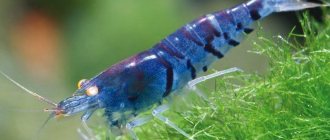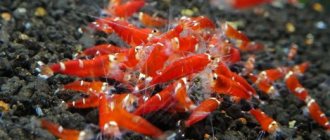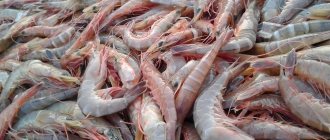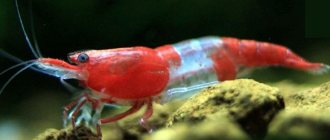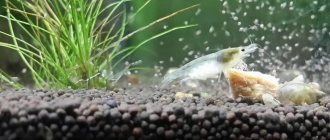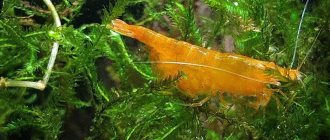Shrimp began to be kept as aquarium pets only recently, but the funny crustaceans have already gained popularity. Blue Dream shrimp is a charming brainchild of foreign breeders. She is not capricious in keeping and feeding; no effort is required for breeding. The blue shrimp looks especially beautiful next to its orange-colored relatives. In addition to its original color, the blue dream shrimp is notable for its sanitary role in the aquarium.
Description
The blue dream shrimp, also called blue corduroy, was developed by breeders from Japan and Germany. The ancestor of the aquarium species is the freshwater shrimp Neocaridina heteropoda.
The main external feature of the aquarium shrimp is its rich blue color with small dark spots. Body color varies among different individuals: the palette varies from opaque intense blue to translucent pale azure.
There are 4 varieties of crustaceans based on color:
- The first is a non-intense and opaque blue color, dark head;
- The second is the presence of small transparent areas, a large dark spot on the head;
- The third is a large number of transparent areas, the dark spot on the head is hardly noticeable;
- The highest grade - the body is almost transparent, there is no darkening on the head.
Translucent individuals are the most valuable, their selection is the most difficult. All varieties may have reddish spots on the body; this feature does not affect the assessment. The intensity and richness of the color are determined not only by genetics, but also by the conditions of detention.
The blue shrimp is dwarf, does not exceed 3 cm in length. The description of appearance is standard: the cephalothorax is covered with a hard and inelastic shell, shed during molting. In addition to 5 pairs of limbs, the shrimp has jaw legs that help push food into the mouth. The tail is long and flexible, helping to make short jumps. The organs of touch and smell are long mustaches.
On molting days, do not remove old shells from the aquarium. They are readily eaten by other underwater inhabitants as a source of nutrients.
Neocaridin species
When choosing neocaridine for an aquarium, shrimp keepers focus on the brightness and unusual color color. The gradation of their types occurs according to this principle.
Riley family
One of the extensive variations of the neocaridine family. Rileys were created by Taiwanese breeders in 2010. All subspecies of these shrimp are distinguished by clear and colorful lines:
- Red Rili (Red-Rili) is recommended for beginner shrimp fishermen, it has a transparent belly, yellow caviar
- Red-Rili-Blu has a bright red tail and head, the middle part of the abdomen is pale blue, and the eggs are yellowish.
- Black-blue Rili (Blue-Carbon-Rili) has a rich black tail and head with a bluish tint, the rest of the abdomen is transparent turquoise with blue-black dots, the eggs are yellow
Other varieties:
- Bloody Mary (Bloody-Mary) is distinguished by its bright, rich scarlet color, one of the most impressively beautiful neocarids
- Painted-Fire-Red, before Bloody Mary, was considered the brightest in color, it also has a red, well-painted color, but is not as colorful as Mary
- Kanoko has a dark burgundy color, with small black spots running down its body, the color of the caviar is also black
- Yellow (Yellow) has a pleasant yellowish color / bright yellow caviar
- Yellow Sakura (Yellow-Sakura) is valued higher than ordinary Yellow, the color is more saturated, golden
- Green Jade (Green-Jade) color varies from greenish-brown to deep green, eggs are dark green in color, there is a stripe running along the back, very unusual and beautiful for a home aquarium
- Blue Dream (Blue-Dream) has a bright blue color with a blackish deep tint, Blue Dream has its own variation - Blue Velvet, distinguished by a soft bluish color
- Blue Diamond - a bright, deep turquoise hue of the body as if illuminated from within, with a blue stripe running down the back
- Chocolate (Schoko) color is light chocolate, along the entire body there are lines resembling cracks from brown to black
- Black Rose (Black-Rose) is completely black, a rather stylish and unusual individual that reproduces quickly and is unpretentious
Many colored neocaridine species can change their color depending on the incident light. For example, black ones take on a scarlet tint, and blue ones become purple.
Care and maintenance
The blue dream shrimp is not capricious in its maintenance and does not require much space. What capacity the tank should have depends on the number of inhabitants. A volume of 20 liters is enough for 12-15 shrimps.
The aquarium must have a lid, since crustaceans are jumping. They start jumping when they are scared or irritated.
Water parameters
The key factor for successful breeding of blue shrimp at home is the quality of water, its purity, air saturation, ideal aeration and filtration. A filter that does not create a strong current is preferable.
Optimal water parameters:
- Temperature - +22-25°C;
- Acidity – 7-8 pH;
- Hardness – 5-15° dH.
Water should be replaced carefully, in portions, avoiding sudden temperature and chemical fluctuations. You cannot use water with low hardness, otherwise after molting the crustaceans will not be able to fully form their shell. The presence of nitrates, ammonia, and copper in aquarium water is unacceptable - these substances are harmful to crustaceans.
Lighting
Artificial light is required. Moreover, it is important not so much for crustaceans as for vegetation. The duration of daylight should be at least 8 hours.
Fluorescent lamps are preferred as a lighting source. They heat up slightly and almost do not provoke temperature fluctuations in the aquarium water. You can attach the lamps not only from above, but also from the side, most importantly - away from the thermometer.
Vegetation
The blue dream shrimp prefers to live in dense thickets, so planting plants in the aquarium is mandatory. Plant ferns, java moss, hornwort, water lettuce. The presence of algae is a must. The use of fertilizers is unacceptable: crustaceans will die.
Priming
The optimal soil for a shrimp aquarium is small pebbles or sand. The thickness of the soil layer must be at least 4 cm.
Decor
When arranging the tank, it is necessary to take into account the places where the shrimp will hide. A complex relief with many decorative elements is preferable. Use driftwood, grottoes, ceramics, piles of stones. You can put dried nettle, hazel, oak leaves on the bottom, and use bamboo stems as decoration. Microorganisms will form on the plant decor, which are food for the shrimp.
Common mistakes
Those who decide to keep shrimp for the first time often encounter certain difficulties. Their pets get sick or even die, although it would seem that everything was done correctly: an aquarium was selected, water and food were prepared, all the necessary equipment was purchased.
Aquarium shrimp can get sick and die if the water in the aquarium is too stagnant
The thing is that small arthropods are very sensitive to various components of the environment. The owner should be aware that the following factors have a detrimental effect on them:
- Insufficiently settled water. Fresh liquid, in which microflora has not yet developed, is detrimental to shrimp, so before the first fill, the water should stand in a dark place for several weeks.
- Tobacco smoke. If you smoke in a room with an aquarium, aquatic inhabitants will not live long in such conditions. Shrimp are so sensitive to smell that they can be harmed even if you put food in them with an unwashed hand that was holding a cigarette.
- Medicines and water stabilizers. Any chemicals that contain the slightest traces of copper have a detrimental effect on arthropods.
Thus, the owner may accidentally make a mistake that will lead to the death of his pets. To prevent this from happening, you need to take responsibility for caring for the inhabitants of the aquarium, and then they will delight you with their beauty and health.
Behavior and Compatibility
Blue shrimp have very interesting behavior. They slowly crawl along the bottom, feeling pebbles and snags with their antennae, and rush to the food abandoned by the owner, pushing each other away.
The ideal habitat is a shrimp tank. But keeping blue dream shrimp in a common aquarium is also possible, the main thing is to choose the right neighbors. The crustaceans themselves are peaceful, but they can be attacked by aggressive fish.
Excellent compatibility of blue shrimp with:
- Neons;
- Guppy;
- Rainbows;
- Rasborami;
- Otocinclus.
Do not put cichlids or other aggressive species in the aquarium, for which small varieties are food. The blue dream shrimp has low compatibility even with calm but large fish. For example, angelfish will not eat crustaceans, but they will certainly pinch them. Helena predator snails will also perceive shrimp as food.
It is not advisable to house blue shrimp with neocaridine relatives of other colors. Controlling reproduction will be problematic. There will be a risk of future generations of crustaceans losing their original coloring.
General characteristics of species
Shrimp appeared in the aquarium in the early 2000s, although domestic aquarists practiced keeping local species back in Soviet times. But interest in them really arose with the import of cherry shrimp from Asia, which has a bright red color. It was with her that the development of breeding and selection of various species began.
Now on sale for the aquarium you can find such species as: Amano, Red and Black Crystal shrimp, various colors of cherry shrimp (blue, red, yellow, orange and even black), Babaulti, Pinocchio, Sulawesi (cardinal, etc.), etc. d. They differ from each other both in color and living conditions, and in types of nutrition. The size of some reaches ten centimeters, while others barely reach two centimeters.
If we talk about scientific names, most aquarium shrimp belong to two genera: Neocaridina (cherry) and Caridina (crystal, babaulti). Although they are similar to each other in size and lifestyle, they belong to different subspecies. And they cannot interbreed with each other.
In nature, shrimp live in shallow streams and river mouths, some prefer cooler or brackish water, others do not tolerate ammonia impurities. A common feature for all is a love for clean and oxygenated water; this should not be forgotten when keeping them in a common aquarium.
Feeding
The main percentage in the diet is algae. If there is a sufficient amount of algal vegetation in the aquarium, shrimp can easily live on pasture. But it's better to feed them. If there is little algae in the aquarium, a mandatory addition is spirulina.
Other supplements include:
- Shrimp food;
- Vegetables processed with boiling water - zucchini, pumpkin, cucumbers;
- Dried nettle, currant, raspberry, cherry leaves.
High protein foods and frozen food are contraindicated. In order for the crustaceans to receive protein, it is enough to give daphnia, live food, once a week.
Feeding should be at the same time 1-2 times a day. Once a week it is useful to organize a day of fasting.
How to feed shrimp
Under natural conditions, neocaridine shrimp feed mainly on carrion. Domestic shrimp are more omnivorous. The diet for them can be compiled as follows:
- small pieces of vegetables (cabbage, zucchini, spinach, cucumbers) and herbs scalded with boiling water;
- bread crumbs, fish pieces, squid, earthworms, bloodworms;
- ready-made feeds (fish food in the form of flakes and granules is suitable);
- special feed created for shrimp.
2-3 hours after feeding, all remaining food must be removed from the container. They quickly dirty the water. And insatiable creatures can overeat, which will have a bad effect on their condition.
Shrimp need to have fasting days. During this period, it is better to clean the shrimp tank from dead organic matter (detritus).
Sex differences
At first it seems that there are no gender differences. In reality, there are several ways to determine gender:
- Females are larger, males rarely exceed 2 cm in length;
- The color of females is more intense;
- Females are more active and energetic;
- In females the belly is rounded, in males the body is elongated;
- In females, the abdominal limbs are equipped with a saddle for bearing eggs.
Reproduction and breeding
Breeding blue dream shrimp does not require special conditions; mature specimens reproduce independently in an aquarium environment.
A female ready for spawning releases pheromones. The attracted male attaches the sperm package to the partner's genital opening. The 20-30 eggs laid are fertilized by passing through sperm. For about a month, the female carries eggs on her abdominal limbs, cares for them, and cleans them.
The hatched fry, up to 1 mm long, are independent. It is difficult to see them: they are transparent and hidden in vegetation. The offspring do not require special feeding or care; small crustaceans feed on phytoplankton and bacteria.
To obtain offspring from blue dream shrimp, breeding must be organized in a shrimp tank. When crustaceans breed in a community aquarium, almost all of the offspring become food for the fish.
What to do with tough shrimp meat?
If the shrimp have become “rubbery”, then it will not be possible to return them to softness and tenderness. However, this does not mean that the product should be thrown away. A picky person can eat them in this form. And to serve seafood, it is better to prepare a dish.
What to do if the shrimp turn out rubbery?
- Cut the meat into thin strips and prepare the salad.
- Stew them in cream or sour cream with the addition of herbs, garlic and seasonings to taste.
- Prepare shrimp sauce and serve over spaghetti or rice.
- Fry the crustaceans (peeled) in a frying pan until golden brown and serve as an appetizer.
Diseases and prevention
Blue shrimp have strong immunity. They rarely get sick, but they can carry an infection that is dangerous for aquarium fish. How long crustaceans live depends on the conditions of detention, but on average 2 years.
When the immune system is weakened, parasitic diseases may occur:
- Defeat by trumpet ciliates and suvoikas;
- False mycosis;
- Damage by fluke worms Scutariella;
- "Porcelain" disease;
- Fusarium or "black gills".
Malachite green and antiparasitic drugs are used for treatment. It is unacceptable to use copper-containing medications. Prevention of weakened immunity in shrimp involves avoiding stress, overcrowding, water pollution, significant fluctuations in temperature and hardness, and nitrate poisoning.
You can buy blue shrimp on the Internet and in a pet store, how much does an individual cost - 100-250 rubles. They are unpretentious, the main thing is to ensure cleanliness, optimal water parameters and balanced nutrition. And then bright crustaceans will decorate the aquarium for a long time.
Checking into the aquarium
So, the container for shrimp is prepared, all the necessary equipment is installed, and the owner has decided on further care. But now the question arises of how to transfer new inhabitants to the aquarium without causing them stress due to a sudden change in conditions.
For check-in to be successful, you must adhere to the following rules:
- Acquire young representatives. Many people are reluctant to take young shrimp because they are dull in color, but this is wrong, as the color will develop as they mature. The older the arthropod, the more difficult it is for it to adapt to new conditions.
- Shrimp should be transported in a plastic bag or container with water and plant branches.
Shrimp should be moved to a new aquarium along with the water in which they were located. - It is necessary to move arthropods to a new container along with the liquid in which they were transported.
- Next, you need to gradually add water prepared in advance to the aquarium and watch the behavior of the shrimp. If everything is calm, you can add liquid to the required volume. If the arthropods begin to bend or rush around, you will have to change the parameters, for example, take more settled or warmer water.
Thus, by taking your time and monitoring the well-being of your new pets, you can successfully place them in a new place of residence.

